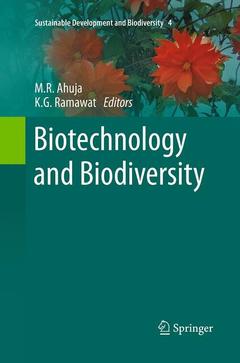Description
Biotechnology and Biodiversity, 2014
Sustainable Development and Biodiversity Series, Vol. 4
Language: English
Subjects for Biotechnology and Biodiversity:
Publication date: 09-2016
Support: Print on demand
Publication date: 10-2014
340 p. · 15.5x23.5 cm · Hardback
Description
/li>Contents
/li>Comment
/li>
Section A. Genetically Modified Plants and Biodiversity.- 1. Transgenic Crops to preserve Biodiversity; C. Emani.- 2. Genetically modified Crops in Africa; G.D. Arthur, K.S. Yobo.- 3. Agriculture and Environmental Impacts of Glyphosate-tolerant Soybean Cultivation in Romania; E.M. Badea, P.I. Otiman.- 4. The Effects of Transgenic Crops on Non-target Organisms; C. Emani.- 5. Agricultural Biotechnology for Health and the Environment; S.O. Hansson.- 6. Next Generation Plant Biotechnology; M.R. Ahuja.- Section B. Biotechnology and Conservation of Biodiversity.- 7. Conservation of Forest Genetic Resources; M. Šijačić-Nikolić at al.- 8. Advances in Cryogenic Techniques for the Long-Term Preservation of Plant Biodiversity; M.T. Gonzalez-Arnao et al.- 9. Biotechnology in Biodiversity Conservation: Overview of its Application on Conservation of Endangered African Tree Species; T.D. Houehanou et al.- 10. Biotechnology for Endangered Plant Conservation; A. Manole-Aifitimie.- 11. Biotechnological approaches to medicinal plants of Aravalli Hills: conservation and scientific validation of biological activities; S. Goyal et al.- 12. Biotechnological approaches towards micropropagation and conservation of Cycads and Ephedrales; M. Dhiman, I. Rautela.- 13. Genetic Resources and Biodiversity Conservation in Nigeria through Biotechnology Approaches; J.U. Ogbu.- 14. Biotechnology Tools for Conservation of the Biodiversity of European and Mediterranean Abies species; J. Krajňáková et al.- 15. Conservation of Global Wheat Biodiversity: Factors, Concerns and Approaches; M. Asif et al.




